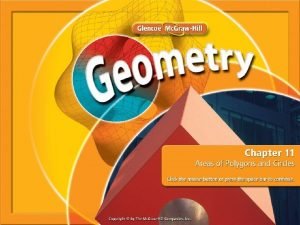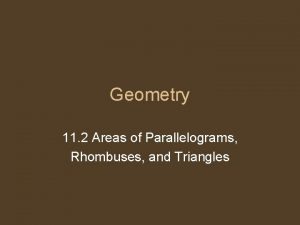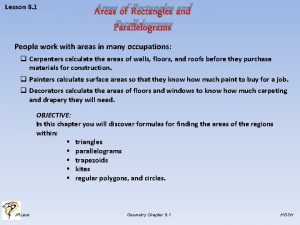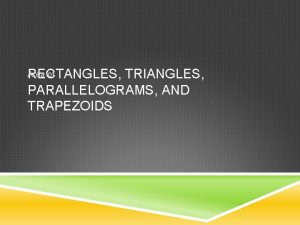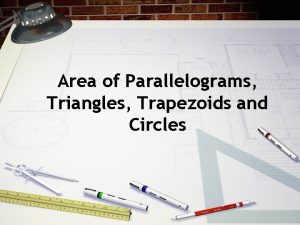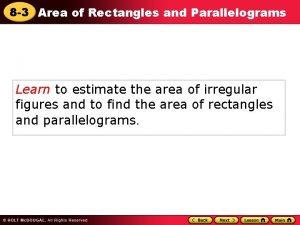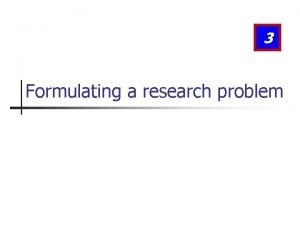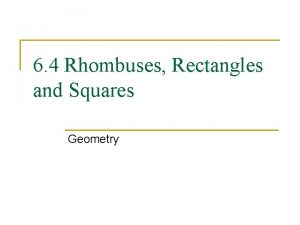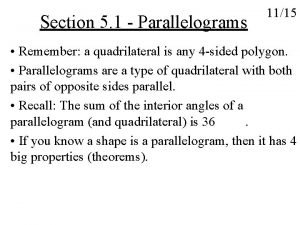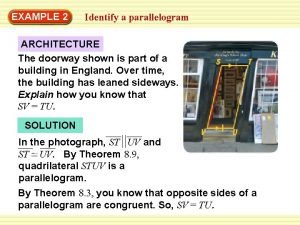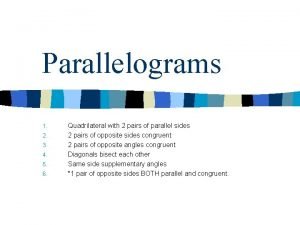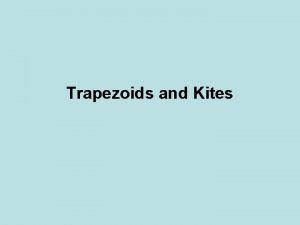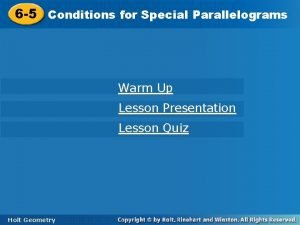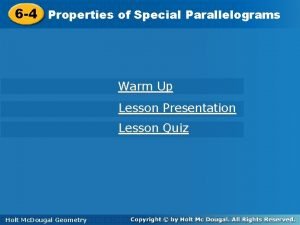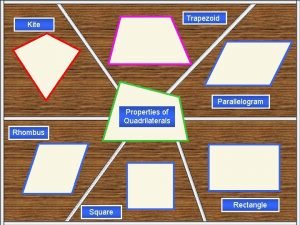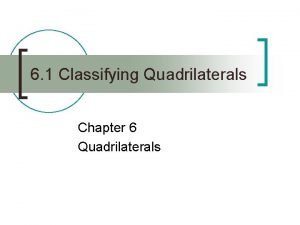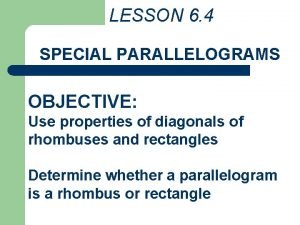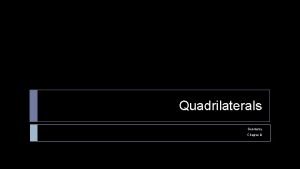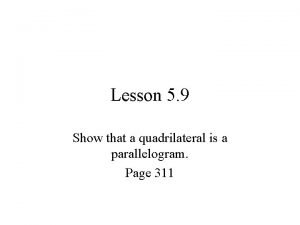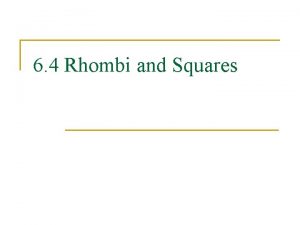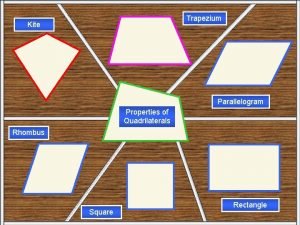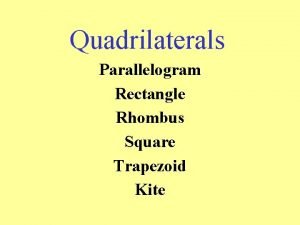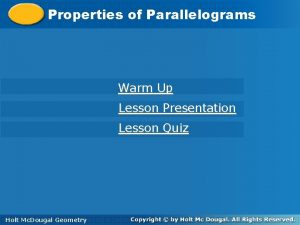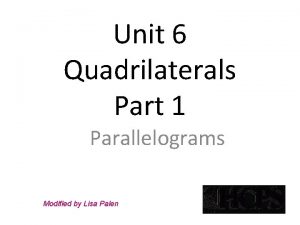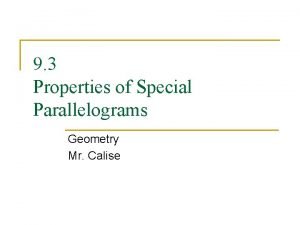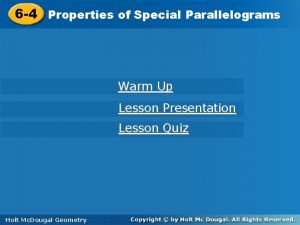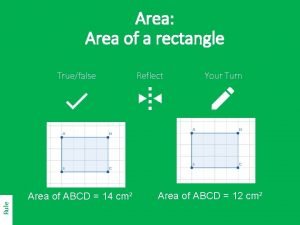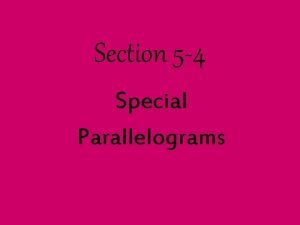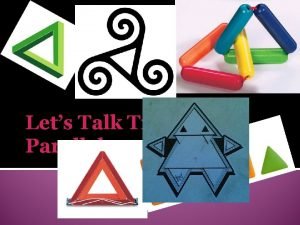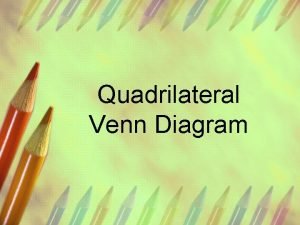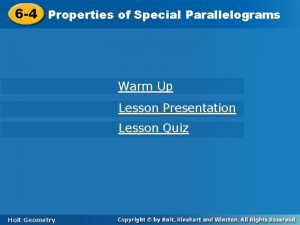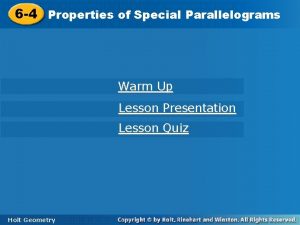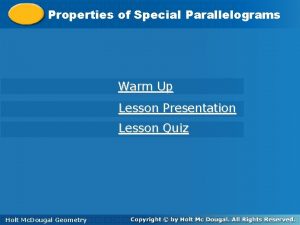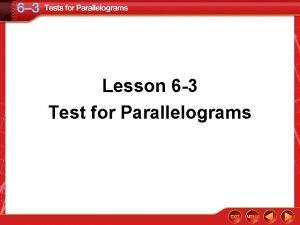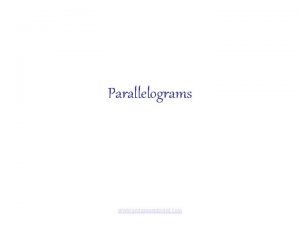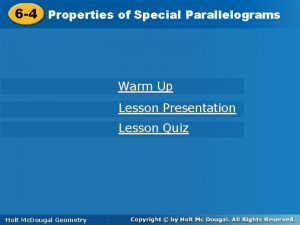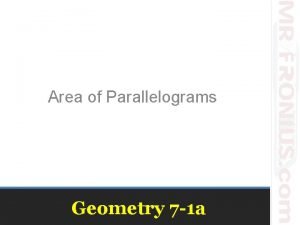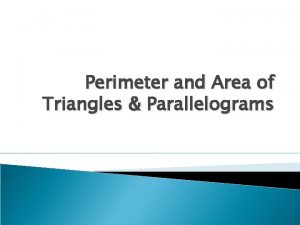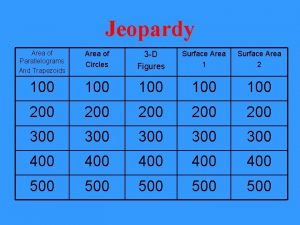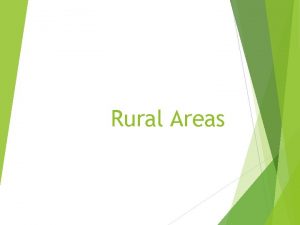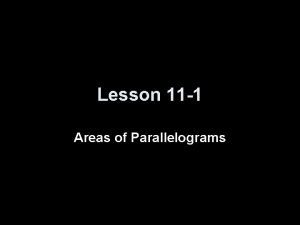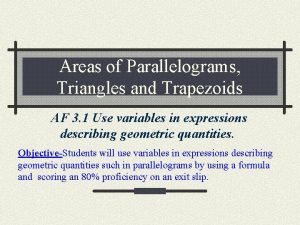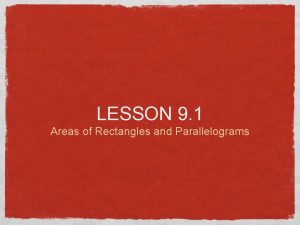DISASTER AREAS 6 G 1 Area of Parallelograms






























- Slides: 30

DISASTER AREAS! 6. G. 1 Area of Parallelograms

Why learn about AREA? Well…. we hear about areas of destruction everyday on the news!

Oklahoma tornado damage, May 1999 F 5 TORNADO: INCREDIBLE … id k n n u r , Ru Who sees the Parallelogram? ?

------ Detective’s -----Tape off an area of a crime sceen to protect the evidence. Need a close-up on 24?

------ Hurricane Katrina -----August 29, 2005 Winds: 125 mph Storm Surge: 30 ft high waves Loss of life: Approximately 1, 500 ig… b s ’ t a Th 80% Flooded Hardest Hit Areas Mississippi Gulf Coast New Orleans

------ Hurricane Katrina -----August 29, 2005 Official disaster area… 90, 000 square miles!

------ Exxon Valdez ------Major oil spill that took place on March 23, 1989 at Prince William Sound in Alaska. Area affected: Gallons spilled: 17, 709 sq miles 11 million

Gulf of Mexico Oil Spill! Deepwater Horizon BP Oil Area affected: 86, 985 square miles! Gallons spilled: 2, 604, 000 gallons per leaked into the day Very sad…

Today’s Lesson Today, we will learn how to find the area of a parallelogram. Students must know the formula and understand why the formula works. • Section 1: What is Area? • Section 2: Exploring the Formula. Decompose and Compose Parallelograms into Triangles and Rectangles to find the area. • Section 3: Identifying the height of a Parallelogram.

Section 1 • Section 1: What is Area? • Section 2: Exploring the Formula. Decompose and Compose Parallelograms into Triangles and Rectangles to find the area. • Section 3: Identifying the height of a Parallelogram.

What is Area? • It is the measure of the space inside of a two-dimensional figure. • Area is measured in something called square units (u²). • To find the area of a figure, you must use specific formulas.

In 5 th grade you learned to find the area of a rectangle. Try this problem! Beth is making a lid for her jewelry box with square tiles as shown below. What is the area of Beth’s jewelry box? 1) What is the formula to find the area of a rectangle? 2) Plug the numbers into your formula. 3) What is the area of the lid to Beth’s jewelry box in square units?

Section 2 • Section 1: What is Area? • Section 2: Exploring the formula. Decompose and compose Parallelograms into triangles and rectangles to find the area. • Section 3: Identifying the height of a Parallelogram.

Explore Activity Area of a Parallelogram We already know that to find the area of a rectangle we use the formula A = b • h. Well, what if I were to tell you that you use the same formula to find the area of a parallelogram? How can that be? Rectangle A=b • h Parallelogram A=b • h Let’s Explore

Explore Activity Area of a Parallelogram • Each of you will be given a parallelogram.

Explore Activity Area of a Parallelogram • Since we know how to find the area of a rectangle, how can we change the parallelogram into a rectangle?

Explore Activity Area of a Parallelogram • Draw a dotted line, perpendicular to the base, to show the triangle you will cut. Fold your paper along this line. • Don’t cut yet!

Explore Activity Area of a Parallelogram • Question… Could the dotted line be drawn in a different location? If so, where? Yes, the dotted line can be drawn in a different location. It could be drawn on the other side of the parallelogram as displayed here.

Explore Activity Area of a Parallelogram • Cut along the dotted line. • Glue both parts of the parallelogram onto a piece of paper to make a rectangle. glue • Why is the new shape classified as a rectangle? Because it is a quadrilateral that has four right angles!

Explore Activity Area of a Parallelogram • Label the base and height of your new rectangle as follows. • How do these measurements compare to the base and height of the parallelogram? They are the same! 3 in. 7 in.

Explore Activity Area of a Parallelogram • What is the area of the rectangle? A = b • h A=7 • 3 Answer: 21 square inches

Explore Activity Area of a Parallelogram • If the are of the rectangle is 21 square inches, what is the area of the original parallelogram? Why? A=b • h A=7 • 3 Answer: 21 square inches Why? Both shapes have the same of space inside.

Explore Activity Area of a Parallelogram • We know that the area of a rectangle is A = base × height. Through this activity we discovered that the formula of a parallelogram would be the same!

You Try Find the area of each parallelogram. Show your work by writing the formula and plugging the numbers into the formula! 1) 2) 3)

Section 3 • Section 1: What is Area? • Section 2: Exploring the formula. Decompose and compose Parallelograms into triangles and rectangles to find the area. • Section 3: Identifying the height of a Parallelogram.

Help! I’m confused! 1) Why is the height the vertical line (8 m) and not the slanted line (10 m)? If we look back to the rectangle we created, the base and height of both the rectangle and the original parallelogram are perpendicular to each other. Therefore, the height of a parallelogram is the perpendicular line segment drawn from the top base to the bottom base.

2) Below are three images of the same parallelogram. Which dotted line shows the proper height of the parallelogram? All three dotted lines are correct! All three heights represent a line segment that is perpendicular to the base. The line is drawn from the top base to the bottom base.

You Try For problems 1 -3 draw and label the height of each parallelogram. 1) 2) 3) 4) A parallelogram in the coordinate plane has the vertices (-3, 5), (4, 5), (-5, -2), and (2, -2). Graph and draw the line segments to form the parallelogram. What is the length of the base and height of the shape?

Closure Area is the measure of the space inside of a 2 -D figure. 1. How is area measured? 2. Describe how you can take this parallelogram and decompose a triangle and use it to compose a rectangle? Square Units Cut the right triangle off one end of the parallelogram and glue it to the other. 3. What is the formula for the area of a parallelogram? Area = base • height or Area = length • width 4. How can you recognize the height of a parallelogram? It is the perpendicular line drawn from the top base to the bottom base.

End of Power. Point
 11-1 areas of parallelograms and triangles
11-1 areas of parallelograms and triangles 7-1 find areas of parallelograms and rhombuses
7-1 find areas of parallelograms and rhombuses Lesson 8.1 areas of rectangles and parallelograms answers
Lesson 8.1 areas of rectangles and parallelograms answers Area rectangles triangles parallelograms trapezoids
Area rectangles triangles parallelograms trapezoids Area of parallelograms triangles and trapezoids
Area of parallelograms triangles and trapezoids Area of rectangles and parallelograms
Area of rectangles and parallelograms Dissect the broad area into sub areas
Dissect the broad area into sub areas Rhombus proofs
Rhombus proofs What are special parallelograms
What are special parallelograms Parallelogram theorems
Parallelogram theorems Family of quadrilaterals
Family of quadrilaterals 6-5 conditions for special parallelograms answer key
6-5 conditions for special parallelograms answer key Is a door parallelogram
Is a door parallelogram Every rhombus is a square
Every rhombus is a square A trapezoid is a kite.
A trapezoid is a kite. 6-5 conditions for special parallelograms
6-5 conditions for special parallelograms 6-4 properties of special parallelograms
6-4 properties of special parallelograms Trapezoid diagonals properties
Trapezoid diagonals properties Classify each quadrilateral in as many ways as possible
Classify each quadrilateral in as many ways as possible Lesson 5.6 properties of special parallelograms answers
Lesson 5.6 properties of special parallelograms answers Quiz 8-1 angles of polygons and parallelograms
Quiz 8-1 angles of polygons and parallelograms Parallelogram non-examples
Parallelogram non-examples 6-5 practice rhombi and squares
6-5 practice rhombi and squares Properties of kite and trapezium
Properties of kite and trapezium Angles of a convex polygon
Angles of a convex polygon Quiz 8-2 parallelograms
Quiz 8-2 parallelograms Consecutive angles are supplementary
Consecutive angles are supplementary Rhombus reason
Rhombus reason 6-4 special parallelograms
6-4 special parallelograms Rectangle rule
Rectangle rule Special parallelograms worksheet answers 5-4
Special parallelograms worksheet answers 5-4
